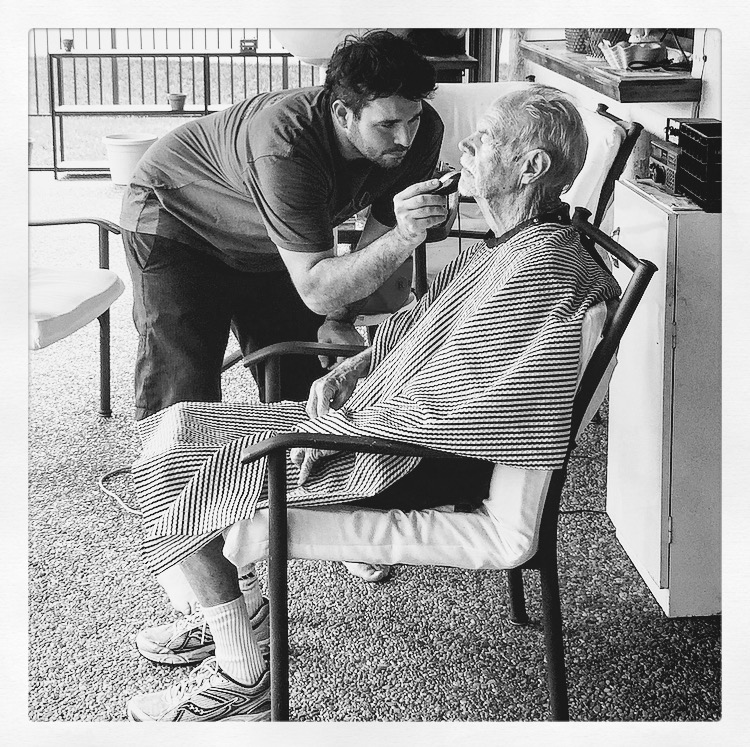Clementine and Walnut Tea Cake With Honey
It’s citrus season which means if you aren’t indulging in crates of those little Cuties, you are missing out! They are easy to peel and typically seedless making them the perfect snack when you’re craving a little something but trying to avoid sheer junk. I’ve been known to down them three or four at a time resulting in odd looks from others in the room. But that’s only until they get their hands on one and next thing you know, they too are deep diving into a citrus bender. Although, I’m not sure there’s such thing as a “citrus bender”. Fresh fruit is nature’s candy and I give myself a free pass when it comes to loading up. But, sometimes you want a more traditional bender. Something with a hint of “bad” diet so you can enjoy the feeling of indulgence. I personally don’t subscribe to any particular diet crazes but I still “get it”. Junk food is a guilty pleasure, the optimal word here being p l e a s u r e…
Aside from the artificial ingredients, it’s the guilt that’s gonna kill us. I heard somewhere that guilt is linked to chronic pain. I have no idea if that’s true, but my gut tells me it is. I developed a relationship with caregiver guilt while I was taking care of my parents and I know it’s something moms also experience when they need to step away from their children. We give ourselves permission to hurt with guilt, acknowledging our “less-thanness” without ever honoring the courage it takes to choose more.
I wish I could say that I’m done with guilt. It’s gotten much better now that my folks have both passed, and I can say that I feel relief and satisfaction from the choices I made along the way. Those choices have not been without consequences and everyday since, I am reminded that my current situation is the result of having CARED for my aging parents. I imagine how different things would be if I didn’t care. I imagine that version of myself would have more money, more success, more stability… But I also imagine that she would have some mental health issues around being a disappointment. I’m not sure I’d be able to look at her squarely in the mirror without shame. I can imagine that my not caring would have manifested into crippling guilt as when a life passes, you realize you can never go back. Amends for mistakes can no longer be shared with those that may have been on the receiving end, ultimately creating more work for you and your psyche. Do you see the problem here?
As we age, we start to lose things. We lose our health, our youthful good looks, and in cases of dementia, even our minds… In some instances maybe that’s not the worst thing. Depending on how we live, we might want to forget, as the anguish of regret becomes its own debilitating burden. Guilt is mental junk food and we need to stop feeding our minds with it! But what does that mean for guilty pleasure? Is there no room? Of course there is! The difference is we own it. We know our indulgent behaviors coax our pleasure receptors and feeling good IS our WHY. So why not? Choose pleasure and stay conscious of the guilt while remaining mindful that you have the c o u r a g e to chose yourself first!
The way I see it, the route to aging better is to care more about the care “giver”. The caregiver is the link between an ailing individual and their quality of life. Whether that means YOU or someone you’ve hired, invest in that person. Take care of that person so they may continue the selfless work they are doing. They are the ones keeping the person, the culture, and ultimately the system from deteriorating. They are the greatest representation of our civil society, filling the crack spaces of social services, many of which flounder in neglect.
Caregivers are destitute. They are working for pennies, if not for free! So good gawd, let them cake! Let’s help them eat some effing cake!!!! Let’s remind them that the village is here, fully intact, and they can rest without guilt because we are here too… sharing the burden because this is how situations get better. People care…
Close-up of all the caramelized citrus goodness…
Ingredients
- 1 1/2 cups flour
- 1 1/2 tsp baking powder
- 1/4 tsp salt
- 2 tsp clementine zest
- 1/3 cup sugar
- 1/2 cup milk
- 1/8 cup heavy cream
- 3 round slices of clementine
- 1/8 cup juice from clementine
- 1 egg
- 1 tbsp olive oil
- 1/2 cup chopped walnuts
- 1 to 2 tsp of honey
Directions
- Preheat the oven to 350 degrees.
- Grease a bread pan and lay your clementine rings in the bottom
- Take two bowls and in one add all the wet ingredients (except the honey) and in the other add the dry. Mix both separately then combine.
- Carefully pour the batter into the bread pan (so as not to shift the rings) and bake for roughly 50 minutes until a toothpick inserted comes out clean.
- When finished baking, carefully remove the bread and cool on a cooling rack.
- Once cooled you can slice the dome that formed while baking, off the "top" and invert the loaf so it rests easily with the celementine rings on full display.
- Then lightly drizzle the honey over the top allowing it to absorb into the cake before cutting into slices.








